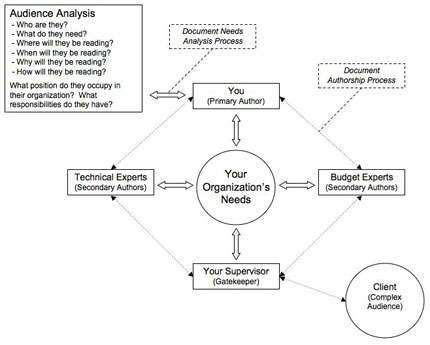The Development Stage

Welcome to the Purdue OWL
This page is brought to you by the OWL at Purdue University. When printing this page, you must include the entire legal notice.
Copyright ©1995-2018 by The Writing Lab & The OWL at Purdue and Purdue University. All rights reserved. This material may not be published, reproduced, broadcast, rewritten, or redistributed without permission. Use of this site constitutes acceptance of our terms and conditions of fair use.
Audience Analysis
A helpful way of gathering information about your readers is to conduct an audience analysis. Depending on the purpose and needs of your documents, you may perform a brief audience profile or an in-depth audience analysis (or something in between). You may expand or contract the following process to match your situation, but remember that the more you know about your potential readers, the more persuasive and user-centered your documents may be.
Some key questions (adapted from Johnson-Sheehan's Technical Communication Today) to ask about your readers are:
- Who are they?
- What do they need?
- Where will they be reading?
- When will they be reading?
- Why will they be reading?
- How will they be reading?
Meeting frequently (in person and/or virtually) with members of your audience to discuss their needs and expectations will also help you compose your documents. The following reader analysis chart (adapted from Johnson-Sheehan) is effective for investigating your audience:
| Readers | Needs | Values | Attitudes |
| Gatekeeper | |||
| Primary | |||
| Secondary | |||
| Shadow |
How readers will use your documents is also important. This context analysis chart (adapted from Johnson-Sheehan) is effective for determining how your audience will use your documents:
| Physical Context |
Economic Context |
Political Context |
Ethical Context |
|
| Primary Readers |
||||
| Readers' Company |
||||
| Readers' Industry |
In addition, determining where your audience sits in their organization may help you understand readers' specific needs. Drawing a chart of your communication's lifecycle will help you gather this information about your audience. The following graphic illustrates the development stage where you might be authoring a document with a team of people in your organization:

Development Stage